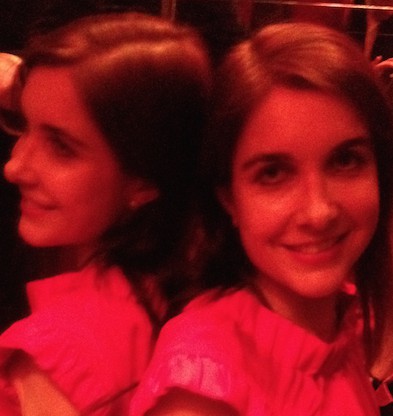Studio Dessuant Bone has always embraced a geometric and intuitively playful, out-of-the-box approach to showcasing the intrinsic qualities of materials and shapes. For the Biennale Interieur in Kortrijk, Belgium, in 2014, the Paris-based studio covered the walls, floor and ceiling of a school classroom awaiting demolition in black plastic sheets, yet left certain places exposed to reveal elements of its architectural heritage. The tiling and windows appeared like artefacts or artworks spotlighted against the theatricality of the backdrop. The previously overlooked historical details were momentarily glorified before becoming a footnote in posterity.
‘It was a crazy installation that some people didn't understand at all, walking out after a few seconds, and that some people loved and spent ages in,’ says British designer Phil Bone, who founded Studio Dessuant Bone with his French girlfriend Marie Dessuant. The dramatic installation intrigued Thomas Allaert, sales manager of Belgian company Allaert Aluminium, who was looking for new ways for his aluminium and glass systems to be used.
For the 25th edition of the Biennale Interieur in Kortrijk in 2016, Studio Dessuant Bone and Allaert Aluminium teamed up to present a series of animated installations titled Perpetual Motion. Fuchsia and grey glass – the kind usually used for doors and windows – rotated within the grid-like installations. A fuchsia circle on the ground delineated the rotational movement of the glass. Overall, the visually strong vocabulary was Mondrian-esque in its abstraction, the industrial glass and frame systems being transposed into the realm of sculpture.
Studio Dessuant Bone and Allaert Aluminium have joined forces again for the first edition of Collectible, the new fair for 21st century design in Brussels (8-11 March in the Vanderborght Building). Low Day Bed and The Day Bed are the culmination of Dessuant and Bone making several trips to the company's warehouse and factory over the course of a year to research materials. Dark grey glass is combined with copper cylinders to create emboldened pieces that juxtapose the transparent fragility of one material with the heavy solidity of the other. Studio Dessuant Bone's idea was to push the materials to the limit.
The Low Day Bed comprises four copper cylinders positioned under a glass rectangle, the form of which recalls a sleigh. Indeed, the piece – which Dessuant describes as ‘a balance of pure geometry’ – engages a dialogue between rotation and gravity. Weighing a total of 70 kilos, the four cylinders are embedded with a moving disc to enable the sculpture to rotate slowly in the exhibition space. ‘We thought it was unique that Thomas could make that movement happen,’ says Bone. ‘It allows a nice interaction with the audience,’ adds Dessuant.
Meanwhile, The Day Bed has a copper cylinder placed horizontally on top of one end of a sheet of glass, while four cylinders act as legs, placed vertically underneath it. In a softer material, the horizontal log would recall a pillow and invite the visitor to recline. Once again, the sculpture teases the imagination whilst encompassing a geometric interplay.
Dessuant and Bone met eight years ago at Fabrica Applied Arts Foundation – the communication research centre in Treviso, northern Italy, which was set up by Luciano Benetton (of the Benetton fashion group) and art director Oliviero Toscani. Back then, Bone was a graphic designer and Dessuant an art director/designer. Encouraged by Sam Baron, creative director of Fabrica's design area, to experiment broadly, the young designers began exchanging viewpoints over the year-long course.
‘Collaborating with people from different disciplines is a nice way to work as a designer,’ says Bone. ‘We started a ping pong of ideas,’ Dessuant confirms. Along with their teammates, they participated in the Objet Préfére exhibition at the CID Grand-Hornu in Belgium in 2011. On show were 15 pieces of furniture conceived following a workshop between Fabrica's designers and staff members that were based on the staff members' favourite objects.
After a stint in London, Dessuant and Bone established their studio in Paris in 2014. Besides furniture for Ligne Roset-Cinna and Le Bon Marché department store in Paris, they have designed a coffee shop for the courtyard of Comme des Garçons' store on Rue du Faubourg Saint-Honoré in Paris. The slick, black-and-white space with sharp, graphic lines evokes a grid-like aesthetic. Similarly, the duo employed a palette of black, white and light woods in their minimal, linear design for the London store of Ron Dorff, an upmarket Swedish sports brand. These commissions find an echo with the studio's projects in collaboration with Allaert Aluminium.
Also on display at Collectible is the Saddle Series of paperweights in various woods and stones that is produced by Collection Particulière, a French home accessories and furnishing company. The sensual, curvilinear pieces again reveal Studio Dessuant Bone's passion for exploring lines and facets, bringing a sculptural dimension to a domestic object.

